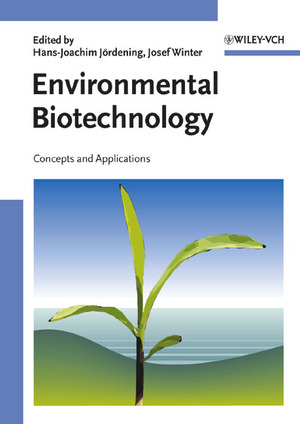Environmental Biotechnology - Jordening and Winter

Preface
Josef Winter, Claudia Gallert, Universitنt Karlsruhe, Germany
Hans-Joachim Jِrdening, Technische Universitنt Braunschweig, Deutschland
The growing awareness of environmental problems, caused especially by the predominate
use of fossil resources in connection with pure chemical pathways of production,
has led the focus on those alternatives, which sounds environmentally
more
friendly. Here, biotechnology has the chance to influence and improve the
quality
of the environment and production standards by:
–
introduction of renewable instead of fossil raw materials
– controlled production of very specific biocatalysts for the
– development of new and environmentally improved production technologies with
less purified substrates and generation of fewer by-products – bioproducts as non-toxic matters, mostly recyclable.
Some impressive studies on industrial applications of biotechnology are published
in two OECD reports, which summarized, that biotechnology has the potential of a
reduction of operational and/or capital cost for the realization of more sustainable
processes (OECD1, OECD2). However, until today the sustainability of technical
processes is more the exception than the rule and therefore so-called “End-of-Pipe”technologies
are absolutely necessary for the treatment of production residues.
In 1972 the Club of Rome published its study “Limits of Growth” and prognosted
an upcoming shortage of energy and primary resources as a consequence of exponential
growth of population and industry (Meadows et al. 1972). Although the
quantitative
prognoses of Dennis Meadows and his research team have not been fulfilled,
the qualitative statements are today well accepted. Aside of a shortage of resources
for production of commodities the limits for an ecologically and economically
compatible disposal of production residues and stabilized wastes have to be
more
and more taken into consideration. The limits for disposal of solid and liquid
pollutants
in soil and water or of waste gases in the atmosphere are a major issue,
since
soil, water and air are no longer able to absorb/adsorb these emissions without
negative
consequences for ecology and life in general. The ultimate oxidation product
of organic residues by incineration or – more smooth – by biological respiration
inaquatic or terrestric environment led to a significant increase of the carbon
diox-ide content of the atmosphere in the last centuries and thus influences the overall
climate. This increase is abundantly attributed to combustion of fossil fuels by traffic
and of fossil fuels and coal for industrial production processes and house heating.
Increasing concentrations of carbon dioxide in the atmosphere from incineration
of fossil energy sources and from decomposition of organic matter are the main
reason
for the greenhouse effect.
Download
*

Preface
Josef Winter, Claudia Gallert, Universitنt Karlsruhe, Germany
Hans-Joachim Jِrdening, Technische Universitنt Braunschweig, Deutschland
The growing awareness of environmental problems, caused especially by the predominate
use of fossil resources in connection with pure chemical pathways of production,
has led the focus on those alternatives, which sounds environmentally
more
friendly. Here, biotechnology has the chance to influence and improve the
quality
of the environment and production standards by:
–
introduction of renewable instead of fossil raw materials
– controlled production of very specific biocatalysts for the
– development of new and environmentally improved production technologies with
less purified substrates and generation of fewer by-products – bioproducts as non-toxic matters, mostly recyclable.
Some impressive studies on industrial applications of biotechnology are published
in two OECD reports, which summarized, that biotechnology has the potential of a
reduction of operational and/or capital cost for the realization of more sustainable
processes (OECD1, OECD2). However, until today the sustainability of technical
processes is more the exception than the rule and therefore so-called “End-of-Pipe”technologies
are absolutely necessary for the treatment of production residues.
In 1972 the Club of Rome published its study “Limits of Growth” and prognosted
an upcoming shortage of energy and primary resources as a consequence of exponential
growth of population and industry (Meadows et al. 1972). Although the
quantitative
prognoses of Dennis Meadows and his research team have not been fulfilled,
the qualitative statements are today well accepted. Aside of a shortage of resources
for production of commodities the limits for an ecologically and economically
compatible disposal of production residues and stabilized wastes have to be
more
and more taken into consideration. The limits for disposal of solid and liquid
pollutants
in soil and water or of waste gases in the atmosphere are a major issue,
since
soil, water and air are no longer able to absorb/adsorb these emissions without
negative
consequences for ecology and life in general. The ultimate oxidation product
of organic residues by incineration or – more smooth – by biological respiration
inaquatic or terrestric environment led to a significant increase of the carbon
diox-ide content of the atmosphere in the last centuries and thus influences the overall
climate. This increase is abundantly attributed to combustion of fossil fuels by traffic
and of fossil fuels and coal for industrial production processes and house heating.
Increasing concentrations of carbon dioxide in the atmosphere from incineration
of fossil energy sources and from decomposition of organic matter are the main
reason
for the greenhouse effect.
Download
*